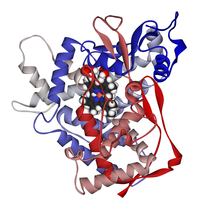
Photo from wikipedia
Two series of novel urea- and amide-functionalized 2,4-disubstituted thiazole derivatives were efficiently synthesized and characterized by 1H nuclear magnetic resonance, 13C nuclear magnetic resonance spectroscopy and high-resolution mass spectrometry. The… Click to show full abstract
Two series of novel urea- and amide-functionalized 2,4-disubstituted thiazole derivatives were efficiently synthesized and characterized by 1H nuclear magnetic resonance, 13C nuclear magnetic resonance spectroscopy and high-resolution mass spectrometry. The target compounds were evaluated for their in vitro antibacterial activity against four bacterial strains, including Staphylococcus aureus, Bacillus subtilis, Escherichia coli, Pseudomonas aeruginosa. The results revealed that the thiazolyl-N-substituted amide derivatives 3a–i showed better antibacterial activity compared with those corresponding substituted phenyl thiazolyl urea analogs 4a–i. The compounds 3a–i were particularly active against gram-positive bacteria. Compounds 3f, 3g, and 4g displayed the potent antibacterial activity. Based on structure–activity relationships studies, we observed that the presence of halogen groups such as chloro or fluoro enhanced the antibacterial activity of newly synthesized compounds.
Journal Title: Medicinal Chemistry Research
Year Published: 2017
Link to full text (if available)
Share on Social Media: Sign Up to like & get
recommendations!